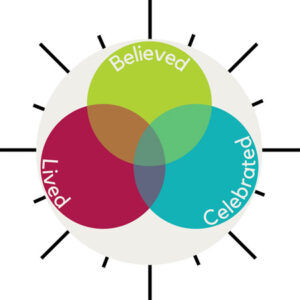By Ella Johnson – Eucharistic Revival Series

My daughter is 7 years old, which means that, in her CCD class, she is now memorizing prayers and learning about the sacraments. I remember doing that, too, when I was her age. As I prepared for my first Communion, I memorized that the Eucharist is a sacrament of initiation, along with baptism and confirmation. But I did not really understand the connection. It made sense to me to think of baptism and confirmation as initiation sacraments, but the reason behind Eucharist being included in this category had me stumped.
Later, when I was in junior high school, my dad joined the Catholic Church. He was baptized as a Lutheran, so I watched him be confirmed and then, in the same ceremony, receive Communion for the first time. It was a special experience for my family to gather around the altar table to receive Communion all together. His baptism, and then confirmation, brought him to the table. His initiation culminated at the altar. The sequence of events led me to the “aha” moment of finally being able to connect the three initiation sacraments.
for the first time. It was a special experience for my family to gather around the altar table to receive Communion all together. His baptism, and then confirmation, brought him to the table. His initiation culminated at the altar. The sequence of events led me to the “aha” moment of finally being able to connect the three initiation sacraments.
I understand now that there are many liturgical opportunities for such an “aha” moment. For instance, the words “the blood of the new and everlasting covenant” remind us of the connection between the initiation sacraments at every eucharistic celebration. Baptism welcomes us into God’s covenantal love, and the Eucharist celebrates, renews and deepens our response to this love.
“Covenant” is, perhaps, one of the best ways to describe God’s love for us. The term signifies bondedness and an irrevocable, unbroken union. As such, it is a central concept in our biblical and liturgical tradition. The Old Testament tells of multiple covenants established between God and Israel, which were often ratified by the blood of animals. Take, for example, the biblical context for Passover, in Exodus 12, in which the blood of the lamb is sprinkled on the doorposts so that the angel would pass over. The New Testament reveals the new covenant in the blood of Christ. The connection between the old and new covenants is made clear in the Gospel of John, which states that Jesus died on the cross the same day that the lambs were being slaughtered for the Passover meal.
Several liturgical rituals also underline this connection. For example, the Easter proclamation (The Exsultet) declares:
“These then are the feasts of Passover,
in which is slain the Lamb, the one true Lamb,
whose Blood anoints the doorposts of believers.”
In addition, at Mass, when the priest raises the consecrated bread above the paten or the chalice, he acclaims:
“Behold the Lamb of God,
behold him who takes away the sins of the world,
Blessed are those called to the supper of the Lamb.”
Participating in the supper of the Lamb, for both the Passover and eucharistic meals, is a means of covenantal renewal. The supper, like the blood of the covenant, is life-giving. In eucharistic Communion, we are obeying Jesus’ command to “take and eat” and “take and drink” of his body and blood poured out for the forgiveness of sins.
Christians are first initiated into the divine life of God in the waters of baptism. This water welcomes us into God’s love, bonding us to God sacramentally. Confirmation seals this bond and completes it. The Eucharist offers us a chance to remember and recommit ourselves to this covenantal bond with God.
The practice of dipping our fingers in baptismal water, when we enter the church, invites us to look back and recall the covenant of baptism and to look forward to the renewal of the covenant in the Eucharist. Kevin Irwin’s “Models of the Eucharist” makes this point by stating: “Water baptism welcomes us into God’s covenantal love throughout his Son’s dying and rising. That covenantal love is reiterated each time we celebrate ‘the blood of the new and eternal covenant’ at the altar table, the Eucharist understood as the ongoing sacrament of initiation.” In other words, “the celebration of the Eucharist is always a renewal of the covenant of baptism.”
Our covenant, begun at baptism and deepened and renewed by our eucharistic Communion, is also stressed in the Rite of Blessing and Sprinkling with Holy Water, designed for the Easter season. After sprinkling the assembly, the priest prays:
“May almighty God cleanse us of our sins,
and through the celebration of this Eucharist
make us worthy to share at the table of his Kingdom.”
The ongoing need for the Eucharist is illustrated in this prayer. It sustains us and transforms us in the covenantal love that begins at our baptism and continues until we need no more covenants, when we are eating the “supper of the Lamb” (Rev 19:9) in the kingdom.
While my 7-year-old may not be able to grasp fully the depth of this connection between baptism and Eucharist, she has always liked to dip her fingers in the baptismal font and she is learning to make the sign of the cross with her wet fingers.
Soon, she will receive her first Communion. The practice of these three actions, in addition to the liturgical prayers mentioned above, provide the foundation and formation to have an “aha” moment, when she will understand the connection of the three sacraments of initiation. The most important “aha” for all of us, of course, is not so much understanding the theological connection between the initiation sacraments as it is recognizing God’s covenantal love for us, and responding to it.
(Ella Johnson, PhD, is an associate professor in the theology department of St. Ambrose University in Davenport.)











